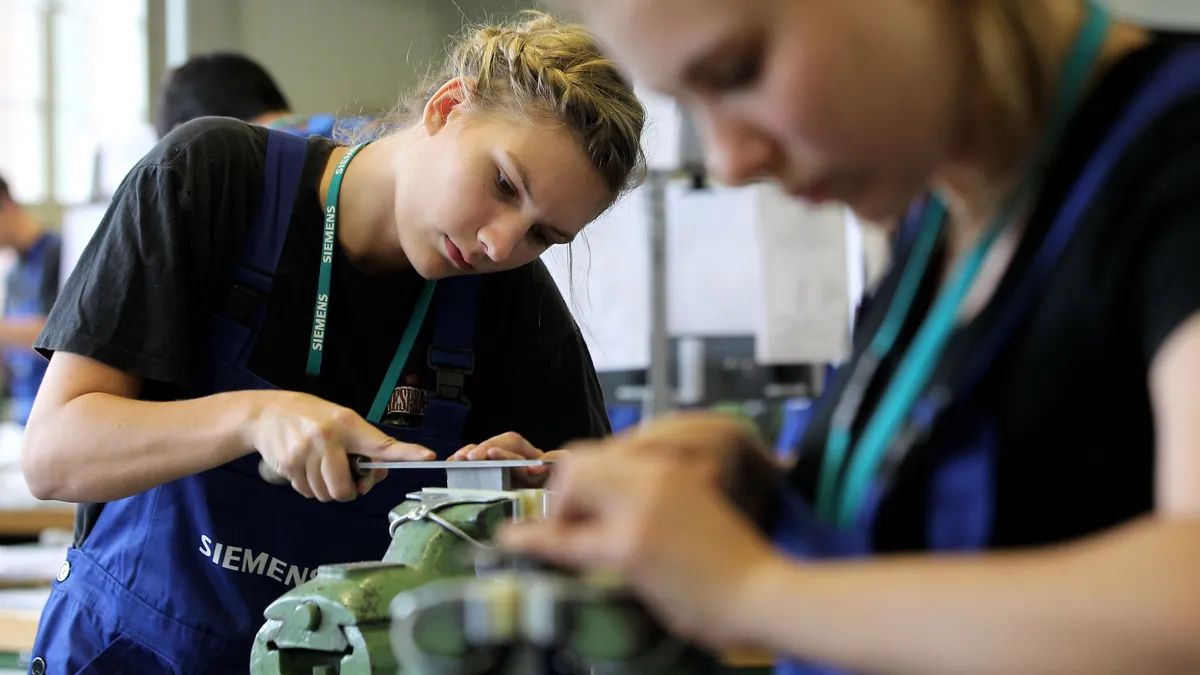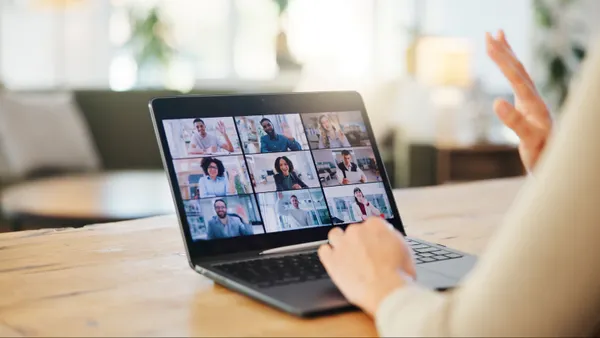Learning and development was in the midst of a sea change when the novel coronavirus hit the U.S., and those in and around the field say the crisis will drive further changes. Among those shifts is an expected increased reliance on new skills and technology due to the proliferation of remote or distributed workforces.
"We know that nearly 85% of L&D functions have shifted their in-person training to virtual, and they have had to make significant changes to all of their programs and offerings — including onboarding, manager development, and HIPO and leadership programs," Sari Wilde, managing vice president in Gartner's HR practice, told HR Dive via email.
One of the greatest challenges L&D leaders faced before COVID-19 was the abundance of choices in learning content delivery, Katy Tynan, principal analyst at Forrester, told HR Dive. Finding the right mix of in-person training, online material and external resources such as executive education or microlearning can be a complex undertaking — one about which workers, managers and learning professionals can have differing opinions.
When the possibility of in-person training went away, L&D was forced to rely on its online infrastructure, which was better for some than others, Tynan said. She added that one of the biggest challenges for many employers was that they delivered their most important training in person, because of the general belief that it is most effective.
"That doesn't mean all online learning is bad," Tynan said. "There are great reasons to do online learning, but you cannot take something that was a classroom class and replicate it in an online environment and expect to get the same learning outcomes."
While some employers may be hoping for the pandemic to end soon so in-person training can resume, some say it may behoove them to build a stronger online suite, even though it could be costly. "It's hard and expensive to create really good online learning programs that actually influence behavior and help people learn new skills," Tynan said. "But if that's the only choice you have, then that's what you have to do."
New world, new skills needed
In addition to the learning environment changing, the skills employers are trying to develop within their workforces have changed as well. In April, Udemy reported a sharp rise in training for "growth mindset" and resilience, as well as for technical subjects such as machine learning and artificial intelligence. Cornerstone Learning said it saw a rise in courses around time management, work-life balance and active listening.
"L&D professionals Gartner surveyed said around 50% to 60% of their workforce had to use new skills in response to the COVID-19 pandemic, and almost six in 10 L&D professionals say their organizations have created new trainings," Wilde said. "Of those who have created new trainings, 82% say their organizations have introduced training on how to work remotely."
More broadly, the learning function, like many of its counterparts across the organization, has had to improve its agility. At the same time, the appetite for learning has increased as well. LinkedIn Learning reported its usage in April 2020 was triple that of February.
"A crisis like the COVID-19 pandemic challenges L&D to become more responsive to business needs," Wilde said. "We see L&D functions doing more dynamic skills-sensing and scenario planning to consider different options for skill needs and learning delivery."
While subject-matter needs may be shifting, learning professionals have many publicly-available options to choose from, so becoming adept in curation is now a priority for maintaining agility, Tynan said.
"There is almost an unlimited amount of relatively high quality content out in the world, and a lot of it is free," she explained. "So the trend that I have seen is that people are in various forms coming into the marketplace saying 'Let us curate this landscape for you.'"
VR's opportunity
One alternative to live training is virtual or augmented reality (VR/AR), which Tynan said is the next best option. The tech, sometimes viewed by many as too expensive and time-consuming to build content for, may see more adoption now that employers can't hold training sessions for large groups.
"From a research perspective, you can build muscle memory doing things in a virtual environment in a way that you cannot in a simple online learning environment," Tynan said.
While a handful of companies have piloted or have isolated uses for VR, and even before the pandemic interest appeared to be on the rise, its applications in the new work environment are likely to expand, experts say.
"Immersive technologies can accelerate performance and increase safety in training and job performance," Sandra Marshall, senior associate at Booz Allen Hamilton wrote in an HR Dive opinion. "Immersive technology enables training for situations that are difficult to replicate, due to lack of access to equipment or the level of difficulty of the task, or the need for the training to be performed multiple times or experienced from another person's point of view, such as customer experience or empathy training."
Marshall also pointed out that once built, immersive training can be scalable and also measure learning effectiveness.
Learning outcome measurement
The move to a virtual work environment has allowed some learning organizations to change how they measure success, Tynan said.
"Smart organizations are leveraging a platform to be the glue in-house for content, and that way the organization can measure utilization of that content, but they don't have to produce it. They don't have to worry about where it comes from, it's sort of pass-through linking," she said. "A lot of learning platforms are moving in that direction."
In addition to measuring training content use, employers now have more opportunities to assess whether employee behavior is changing as a result of training.
"Why would we do a learning program if we weren't ultimately trying to change someone's behavior at the end of it, whether it's improving their skills, [or] changing how they interact?" Tynan said. "I think there's an opportunity, especially when we're interacting in this digital world, now, there's an opportunity to capture more data."


















